To capture stunning wedding group shots from above, you'll need the right equipment and careful planning. Invest in a high-quality drone with at least a 12-megapixel camera and 3-axis gimbal stabilizer. Scout your location in advance, considering lighting and potential obstacles. Coordinate with your wedding planner to schedule the perfect time for aerial photos, typically during golden hour. Position guests creatively, forming shapes like hearts or initials for unique compositions. Don't forget to obtain necessary permits and follow local drone regulations. With proper preparation and execution, you'll create breathtaking aerial memories that showcase the scale and beauty of your special day. The sky's the limit for unforgettable wedding photography!
Key Takeaways
- Use a drone with a high-quality camera and stabilizer for smooth, high-resolution aerial shots.
- Plan formations carefully, considering geometric shapes and incorporating landscape features for visual interest.
- Schedule shots during golden hour for optimal lighting and adjust positioning to avoid harsh shadows.
- Coordinate closely with the wedding planner to integrate aerial shots seamlessly into the event timeline.
- Ensure compliance with drone regulations, obtain necessary permits, and prioritize safety throughout the shoot.
Choosing the Right Drone
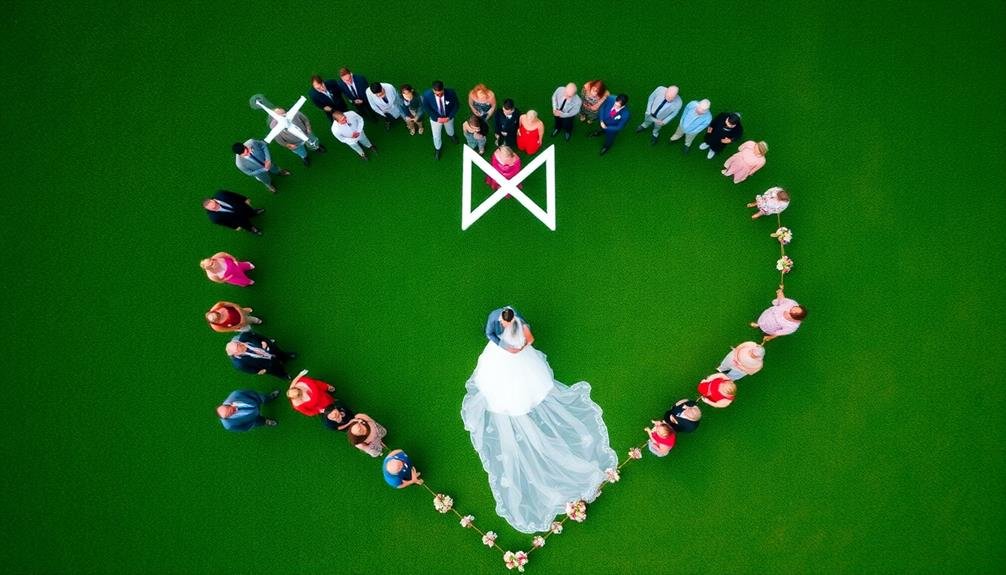
When it comes to choosing the right drone for wedding group shots, you'll want to contemplate several key factors.
First, consider the drone's camera quality. Look for a model with at least a 12-megapixel camera and 4K video capabilities to guarantee sharp, high-resolution images. Opt for a drone with a 3-axis gimbal stabilizer to minimize camera shake and produce smooth footage.
Flight time is vital, so select a drone that can stay airborne for at least 20 minutes on a single battery charge. This will give you ample time to capture multiple group shots without interruption.
Additionally, choose a drone with intelligent flight modes, such as orbit or follow-me features, which can help you create dynamic aerial shots effortlessly.
Don't forget about portability. A compact, foldable drone will be easier to transport and set up quickly during the wedding day.
Finally, consider the drone's noise level. Quieter models are less likely to disrupt the ceremony or distract guests.
Planning Your Aerial Shot
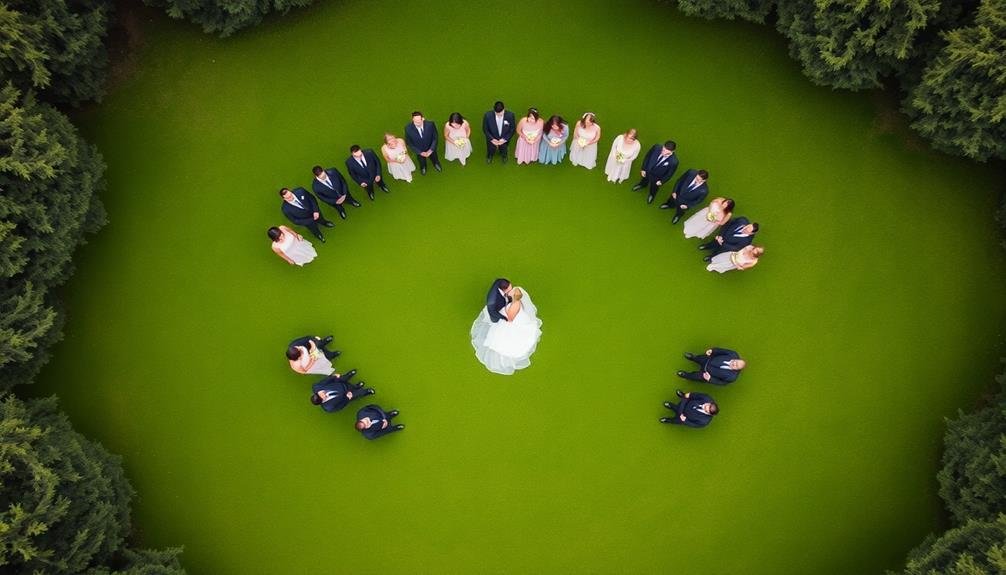
Several key steps are essential when planning your aerial shot for wedding group photos. First, scout the location in advance to identify the best vantage points and potential obstacles.
Consider the sun's position and how it'll affect lighting throughout the day. Choose a time when shadows won't interfere with your composition.
Next, create a detailed shot list with specific formations you want to capture. Communicate these plans clearly to the wedding party and coordinator. You'll need to arrange people quickly and efficiently, so having a plan is vital.
Consider the wedding attire when planning your shots. Light-colored dresses and suits will stand out better against darker backgrounds. If possible, incorporate the venue's architecture or natural landscape into your compositions for added visual interest.
Safety is paramount. Confirm you're following all local regulations for drone usage. Brief your team on safety procedures and establish a clear communication system. Have a spotter to keep an eye on the drone and surroundings.
Lastly, practice your planned shots beforehand if possible. This will help you refine your technique and identify any potential issues before the big day.
Coordinating With Wedding Planner
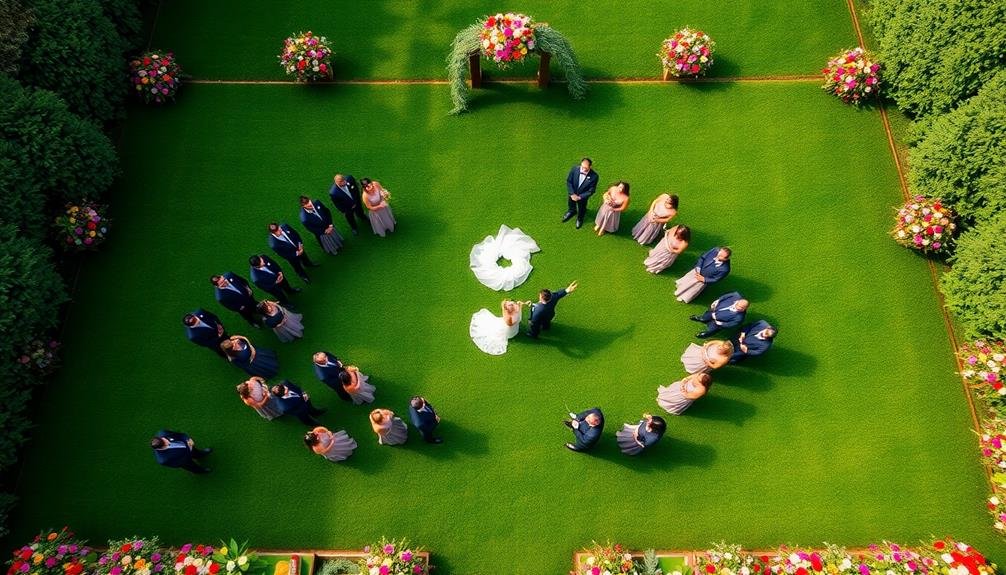
Collaboration with the wedding planner is essential for successful group shots. You'll need to work closely with them to guarantee your aerial photography aligns with the overall wedding schedule.
Start by discussing your plans early in the planning process. Share your vision for the aerial shots and ask about any potential venue restrictions or time constraints.
Coordinate the timing of your group shots with the planner's timeline. You'll want to find a balance between capturing the perfect lighting and not disrupting other wedding events. Ask the planner to allocate a specific time slot for your aerial photography, ideally during a natural break in the day's activities.
Discuss the location options with the planner, as they'll have insights into the best spots at the venue. They can also help arrange any necessary permits or permissions for drone use.
Collaborate on creating a detailed shot list, including specific group formations and any props you'll need. Finally, ask the planner to brief the wedding party about the aerial shots, guaranteeing everyone knows where to be and when.
This coordination will help you capture stunning aerial group photos efficiently and without causing delays in the wedding day schedule.
Timing and Lighting Considerations
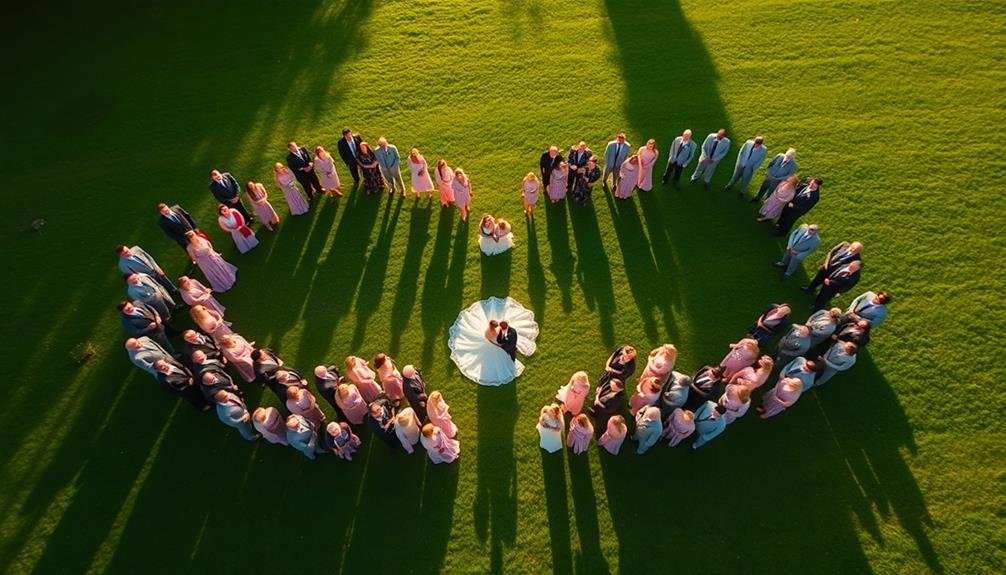
When planning your wedding group shots, timing and lighting are essential factors to take into account.
You'll want to capitalize on the golden hour, typically just before sunset, when the light is soft and warm, creating a magical atmosphere for your photos.
Be mindful of the sun's position throughout the day to avoid harsh shadows on faces, and work with your photographer to schedule group shots during ideal lighting conditions.
Golden Hour Magic
The golden hour, that magical time just before sunset, offers wedding photographers a unique opportunity to capture stunning group shots. During this period, the soft, warm light creates a flattering glow that enhances skin tones and adds depth to your images.
To make the most of this fleeting moment, you'll need to plan ahead and work efficiently. Start by scouting locations that face west, allowing you to capture the golden light as it bathes your subjects. Position your group with the sun behind them for a beautiful backlit effect, or have them face the sun for a warm, glowing look.
You'll want to work quickly, as the light changes rapidly during this time. Consider using a wider aperture to create a dreamy, romantic atmosphere, but be careful to maintain focus on all subjects.
Don't forget to experiment with different compositions. Try shooting from above to capture the interplay of light and shadow across the group. Use natural elements like trees or architecture to frame your subjects and add interest to your shots.
Avoiding Harsh Shadows
While golden hour offers ideal lighting conditions, you'll often need to shoot group photos at other times of the day. To avoid harsh shadows, pay attention to the sun's position and adjust your shooting strategy accordingly.
When the sun is high, seek out shaded areas like under trees or buildings. These natural light diffusers soften shadows and create more flattering images.
If shade isn't available, use artificial lighting to fill in shadows. A flash or reflector can help balance the light and reduce contrast. Position your subjects so the sun is behind them, creating a rim light effect, and use your flash to illuminate their faces. This technique prevents squinting and unflattering facial shadows.
Consider the time of day when scheduling group shots. Mid-morning or late afternoon usually provide softer light than midday. If you must shoot at noon, try to find an open shade area or create your own using a large diffuser.
Alternatively, move indoors and use window light for a softer effect. Remember, consistent lighting across all subjects is key for cohesive group photos, so adjust your position or lighting setup as needed to achieve even illumination.
Guest Positioning Techniques
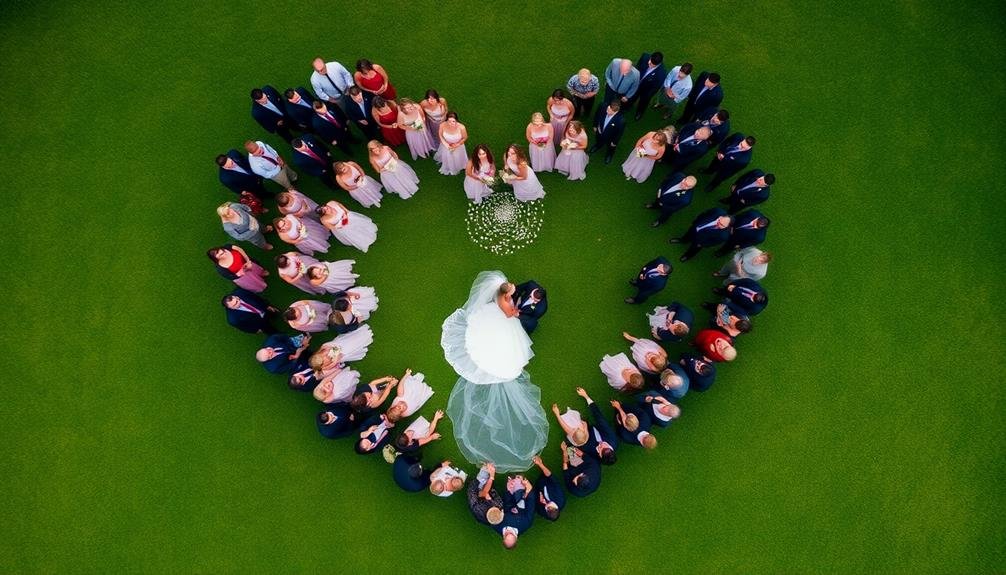
Arranging guests in wedding group shots calls for a mix of creativity and practicality. You'll want to create visually appealing compositions while ensuring everyone is visible and comfortable. Start by positioning the newlyweds at the center, then build outward with family members and close friends.
Consider height variations to add depth to the image, placing taller individuals towards the back and shorter ones in front.
When shooting from above, you'll need to adapt your positioning techniques. Here are three key strategies to implement:
- Create geometric shapes: Arrange guests in circles, squares, or triangles for a striking aerial view.
- Use props creatively: Incorporate items like umbrellas or flower petals to form patterns visible from above.
- Utilize available landscape features: Position guests along curved pathways or around fountains for natural, flowing compositions.
Remember to communicate clearly with your subjects, giving precise instructions on where to stand and how to angle themselves.
Don't hesitate to make adjustments as needed – sometimes small tweaks can dramatically improve the overall composition.
Creative Formation Ideas

When planning your wedding group shots, consider incorporating creative formation ideas to add a unique touch to your photos.
You can arrange your guests in a heart-shaped crowd formation, symbolizing love and unity. Alternatively, try organizing people to form the couple's initials or wedding date, or create symbolic shapes that represent your relationship or shared interests.
Heart-Shaped Crowd Formation
One of the most visually striking and romantic group formations for wedding photos is the heart-shaped crowd. This timeless arrangement symbolizes love and unity, making it perfect for capturing the essence of your special day. To create this formation, you'll need a large open space and an elevated vantage point for the photographer.
Start by outlining the heart shape on the ground using rope or chalk. Position your guests along the outline, ensuring they're evenly spaced. Fill in the center of the heart with remaining guests, leaving some space between them for a natural look.
For the best results, consider these tips:
- Dress code: Ask guests to wear coordinating colors to create a cohesive look from above.
- Props: Provide colorful umbrellas or balloons for guests to hold, adding visual interest.
- Timing: Plan this shot during golden hour for warm, flattering light.
Remember to communicate clearly with your guests and have a few helpers to guide them into position.
With proper planning and execution, your heart-shaped crowd photo will become a cherished memento of your wedding day, showcasing the love and support surrounding you and your partner.
Initials or Numbers Layouts
Creative formation ideas like initials or numbers layouts offer a personalized touch to your wedding group photos. These designs allow you to showcase meaningful letters or numbers, such as your initials, wedding date, or anniversary year. To execute this concept, you'll need to plan ahead and communicate clearly with your guests.
Start by choosing a simple design that's easy to form. You'll want to create a template or outline on the ground to guide your guests into position. Consider using tape, rope, or even flower petals to mark the shape. Remember, simpler designs work best for larger groups.
Here's a quick reference guide for planning your initials or numbers layout:
| Design Element | Small Group (20-50) | Large Group (50+) |
|---|---|---|
| Letter Size | 10-15 feet | 20-30 feet |
| Number Size | 8-12 feet | 15-25 feet |
| Outline Width | 2-3 people wide | 3-4 people wide |
| Spacing | 1-2 feet apart | 2-3 feet apart |
When positioning your guests, start with the outline and then fill in the center. Don't forget to account for different heights by placing taller individuals in the back. Finally, confirm your photographer has access to an elevated position or drone to capture the full effect of your creative layout.
Symbolic Shapes Arrangement
Arranging your wedding party into symbolic shapes offers a unique and meaningful twist on traditional group photos. You'll create visually striking images that carry deeper significance for your special day. Consider forming shapes that represent love, unity, or personal meaning to you as a couple. Hearts, infinity symbols, or interlocking rings are popular choices that photograph beautifully from above.
To execute this creative formation successfully:
- Plan the shape in advance and communicate it clearly to your wedding party.
- Use props or markers on the ground to guide participants into position.
- Have a designated person direct from ground level while the photographer captures from above.
Don't hesitate to get creative with your chosen shape. You might opt for a cultural symbol, your shared initials, or even an abstract design that holds special meaning for you both.
Remember to keep the formation simple enough for your guests to understand and maintain. With careful planning and clear communication, you'll capture a truly memorable group shot that stands out in your wedding album and tells a unique story of your love and union.
Safety Precautions
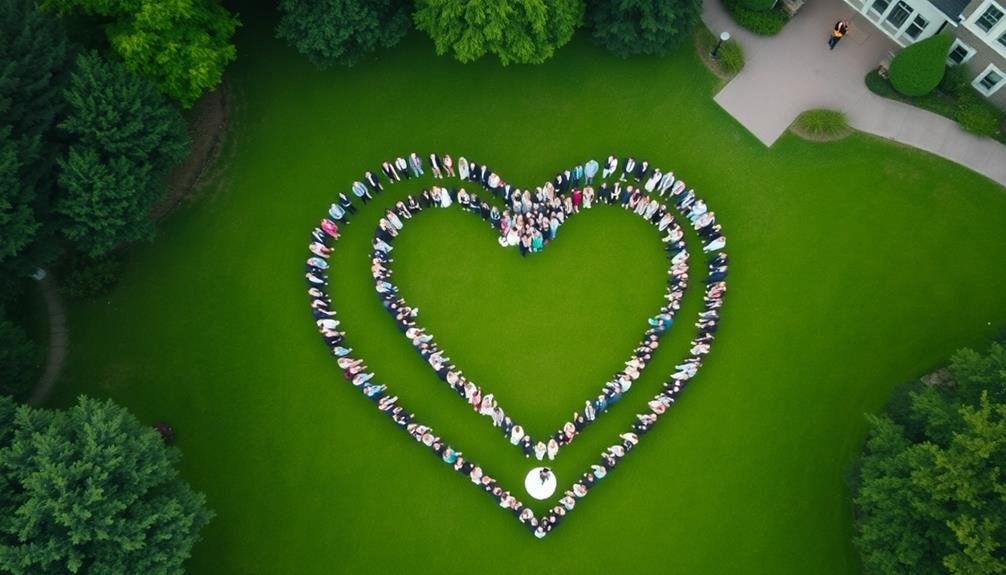
During group shots, safety should be your top priority. When organizing aerial wedding group photos, you'll need to take into account potential hazards and take necessary precautions. Make certain the ground is stable and free from obstacles that could cause trips or falls. If you're using elevated platforms or structures, verify their stability and weight capacity.
Brief your guests on safety procedures before arranging the shot. Assign a safety coordinator to oversee the process and assist those who may need help. When using drones for aerial photography, hire a licensed operator who follows local regulations and maintains a safe distance from the group.
Here's a quick safety checklist for aerial group shots:
| Safety Measure | Responsibility | Importance |
|---|---|---|
| Ground inspection | Photographer | High |
| Guest briefing | Coordinator | High |
| Equipment check | Drone operator | Critical |
| Weather assessment | Photographer | Medium |
| Emergency plan | Coordinator | High |
Remember to have a first aid kit on hand and know the location of the nearest medical facility. By prioritizing safety, you'll make certain a smooth and enjoyable experience for everyone involved in creating these memorable wedding group shots.
Capturing Multiple Angles
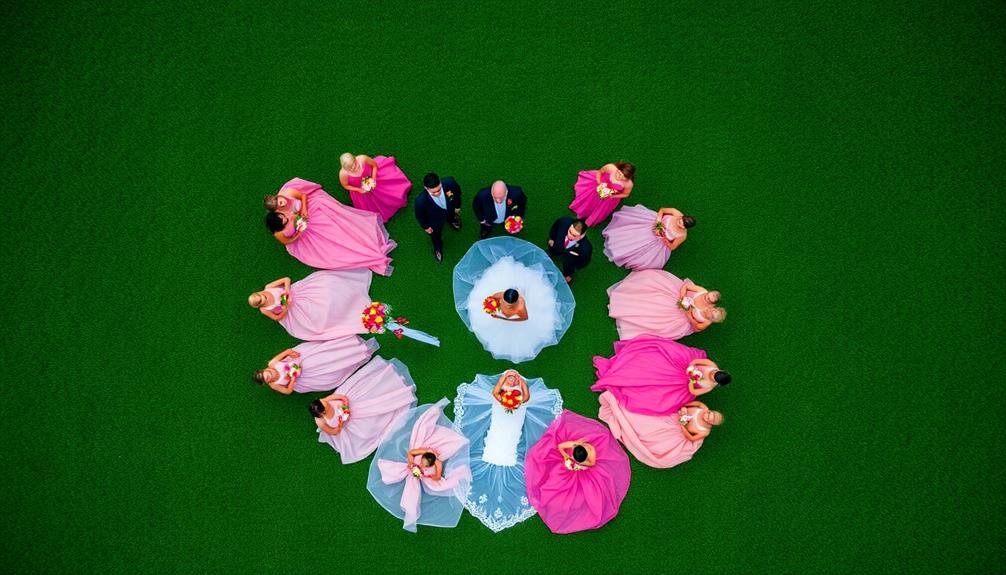
In addition to the traditional group shot, capturing multiple angles can dramatically enhance your wedding photo collection. By exploring different perspectives, you'll create a diverse and dynamic set of images that truly capture the essence of your special day.
Don't be afraid to get creative and experiment with various vantage points.
To achieve stunning results, consider these techniques:
- Elevated shots: Use a drone or find a high vantage point to capture the entire wedding party from above. This unique perspective showcases the layout of the venue and the scale of your celebration.
- Close-up details: Zoom in on small groups or individual faces to capture emotions and intimate moments within the larger gathering. These shots add depth and personality to your album.
- Wide-angle views: Step back and use a wide-angle lens to include the surrounding landscape or architecture in your group shots. This technique provides context and showcases the beauty of your chosen location.
Remember to communicate clearly with your photographer about the angles you'd like to explore.
They may have additional ideas based on their experience and the specific features of your venue.
Post-Processing for Aerial Photos
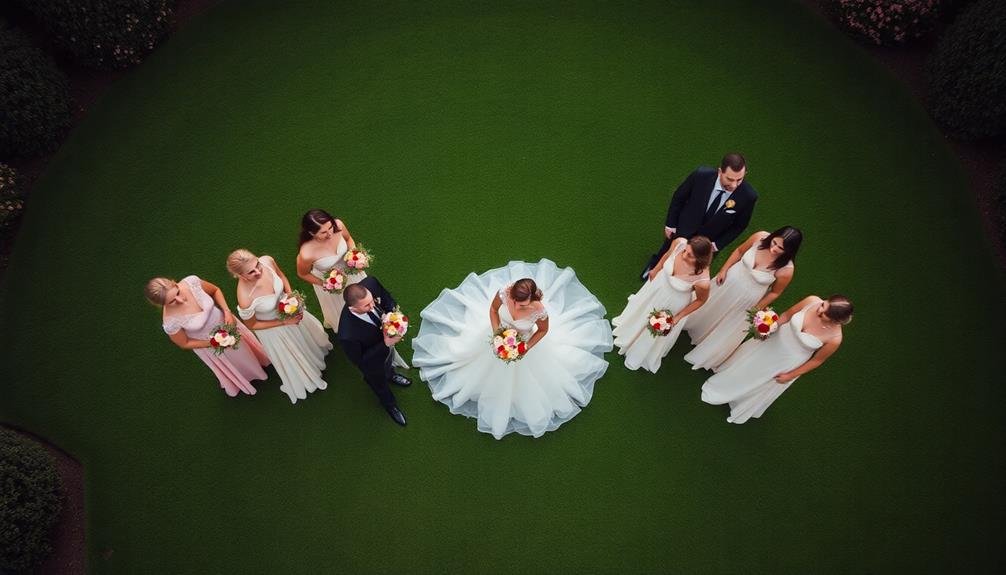
Post-processing for aerial photos can take your wedding group shots from good to extraordinary. When editing these images, focus on enhancing clarity, color, and composition to make the group stand out against the landscape.
Start by adjusting the exposure and contrast to balance the brightness across the entire image. Next, fine-tune the colors to create a cohesive look that complements the wedding's color scheme. Pay special attention to the sky, as it often dominates aerial shots.
Use selective editing tools to bring out details in the group while maintaining the overall scene's integrity. Don't forget to straighten the horizon and crop if necessary to improve composition.
Here's a quick guide to common adjustments for aerial wedding photos:
| Adjustment | Purpose | Typical Range |
|---|---|---|
| Exposure | Balance overall brightness | -0.5 to +0.5 |
| Contrast | Enhance depth and dimension | +10 to +30 |
| Saturation | Boost color vibrancy | +5 to +15 |
| Clarity | Improve detail and texture | +10 to +25 |
| Dehaze | Reduce atmospheric haze | +5 to +20 |
Remember to maintain a natural look and avoid over-processing. Subtle adjustments often yield the best results, preserving the authenticity of your aerial wedding group shots while enhancing their visual impact.
Equipment Essentials
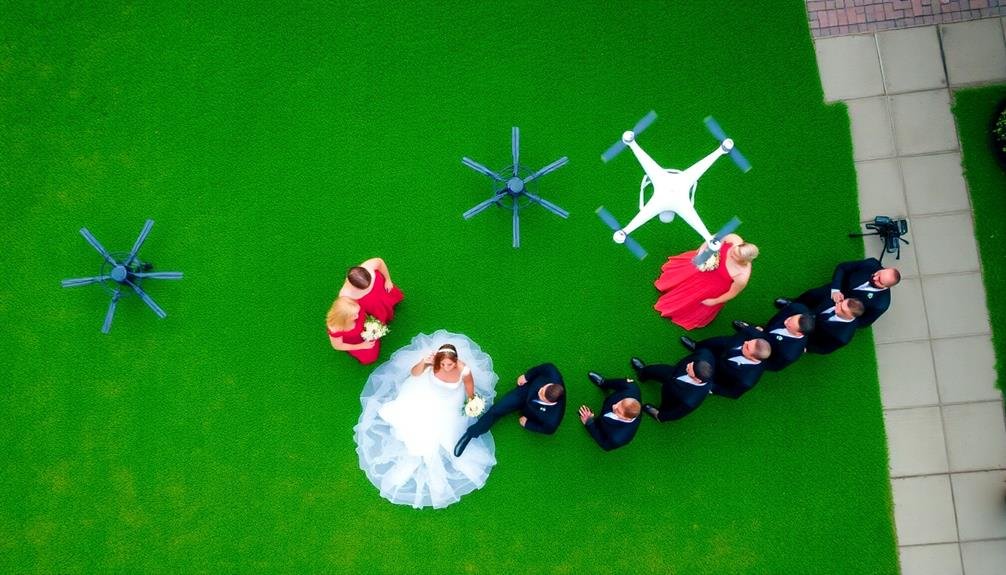
Capturing stunning wedding group shots requires a carefully curated set of equipment essentials. To achieve those breathtaking aerial shots, you'll need a reliable drone with a high-quality camera. Look for models with at least 4K resolution and good low-light performance.
Don't forget extra batteries and propellers to guarantee uninterrupted shooting throughout the day. A wide-angle lens is vital for capturing large groups from above. Opt for a lens with a focal length between 16-35mm to fit everyone in the frame while maintaining image quality.
You'll also need a sturdy tripod for ground-level shots and a remote shutter release to minimize camera shake. To elevate your aerial wedding photography, consider these additional equipment essentials:
- ND filters to control exposure in bright outdoor settings
- LED light panels for fill light in shadowy areas
- A tablet or large smartphone for better drone control and live view
Remember to pack all your gear in a weatherproof bag and bring along cleaning supplies to keep your equipment in top condition throughout the event.
With these essentials, you'll be well-prepared to capture stunning wedding group shots from above.
Legal Requirements for Drone Use

If you're planning to use drones for wedding photography, you'll need to comply with specific legal requirements.
Familiarize yourself with licensing and certification requirements, as well as no-fly zones in your area.
Don't forget to secure proper insurance and understand your liability as a drone operator.
Licensing and Certification Requirements
Drone operators' legal obligations have become increasingly important for wedding photographers looking to capture aerial shots. If you're planning to use a drone for wedding photography, you'll need to comply with specific licensing and certification requirements set by aviation authorities.
In the United States, the Federal Aviation Administration (FAA) regulates drone usage. To legally operate a drone for commercial purposes, including wedding photography, you must:
- Obtain a Remote Pilot Certificate by passing the FAA's Aeronautical Knowledge Test
- Register your drone with the FAA
- Follow all applicable FAA rules and regulations for commercial drone operations
You'll need to study topics such as airspace classification, weather patterns, and emergency procedures to pass the knowledge test. Once certified, you must keep your license current by completing recurrent training every 24 months.
It's essential to stay informed about local regulations, as some areas may have additional restrictions on drone usage.
Always check for any temporary flight restrictions in your shooting location and obtain necessary permissions from property owners or event venues.
No-Fly Zones Awareness
Understanding and adhering to no-fly zones is essential for drone operators in wedding photography. You'll need to be aware of restricted airspace, such as airports, military bases, and national parks. Before each wedding shoot, research the location thoroughly and check for any temporary flight restrictions (TFRs) that may be in effect.
Use official sources like the FAA's B4UFLY app or website to verify the airspace classification of your shooting location. Remember that even if you're not in a restricted area, you must still follow general drone regulations, including maintaining visual line of sight and not flying over people.
| No-Fly Zone Type | Examples | Considerations |
|---|---|---|
| Permanent | Airports, Military Bases | Check radius of restriction |
| Temporary | Sporting Events, VIP Visits | Verify duration of TFR |
| Sensitive | Government Buildings, Prisons | May require special permission |
| Local Ordinances | Parks, Beaches | Research city-specific rules |
Always prioritize safety and legal compliance in your drone operations. If you're unsure about a location's status, contact local authorities or the FAA for clarification. By staying informed and respectful of no-fly zones, you'll protect yourself legally and maintain a professional reputation in the wedding photography industry.
Insurance and Liability
Beyond knowing where you can and can't fly, it's vital to protect yourself legally when operating a drone for wedding photography.
You'll need to secure proper insurance coverage and understand your liability as a drone operator. Most standard photography insurance policies don't cover drone-related incidents, so you'll need to obtain specific drone liability insurance.
This specialized coverage protects you from potential lawsuits arising from accidents, property damage, or privacy violations. It's important to have this insurance in place before you start offering drone photography services for weddings.
In addition to insurance, you should be aware of your legal responsibilities as a drone operator. Here are three key areas to focus on:
- FAA registration and certification requirements
- Local and state regulations regarding drone use
- Privacy laws and obtaining necessary permissions from property owners and wedding guests
Communicating With Wedding Guests

Before the big day arrives, it's crucial to establish clear communication with wedding guests about group photo plans. Inform them well in advance about the scheduled time and location for group shots. Include this information in your wedding invitations or on a separate insert. You can also create a wedding website or use social media to share these details.
Encourage guests to arrive punctually for the group photos. Explain the importance of their participation and how it contributes to capturing memories of the special day. If you're planning aerial shots, let guests know so they can prepare accordingly, perhaps by coordinating outfits or bringing props.
On the wedding day, designate a reliable person, such as the best man or maid of honor, to help coordinate guests for the group shots. They can make announcements, gather people, and make sure everyone is in place. Consider using a PA system for larger weddings to efficiently communicate with guests.
Be prepared to give clear, concise instructions during the photo session. Use a friendly but firm tone to keep things moving smoothly. Remember to thank your guests for their cooperation and patience throughout the process.
Frequently Asked Questions
How Much Does It Cost to Hire a Drone Photographer for Weddings?
You'll typically spend between $500 and $2,000 for drone wedding photography. Prices vary based on the photographer's experience, shoot duration, and location. Consider package deals that include both ground and aerial coverage for the best value.
Can Aerial Shots Be Taken Indoors or Only Outdoors?
You can take aerial shots both indoors and outdoors. For indoor shots, you'll need a spacious venue with high ceilings. Outdoors offers more flexibility, but indoor shots can create unique, intimate perspectives for your wedding photos.
What Happens if the Weather Is Bad on the Wedding Day?
If the weather's bad on your wedding day, don't panic. You've got options. Move indoors for aerial shots using balconies or staircases. Alternatively, embrace the rain with clear umbrellas for unique outdoor photos. Always have a backup plan ready.
How Long Does It Take to Get the Final Aerial Photos?
You'll typically receive your final aerial wedding photos within 2-4 weeks. However, it can vary depending on the photographer's workload and editing process. Don't hesitate to ask your photographer for their specific turnaround time.
Are There Restrictions on Using Drones Near Historical or Protected Wedding Venues?
You'll often face restrictions when using drones near historical or protected wedding venues. It's essential to check local regulations and obtain necessary permits. Some sites may completely prohibit drone use, while others might require special permission.
In Summary
You've now got the tools to capture breathtaking aerial wedding group shots. Remember, it's all about preparation, coordination, and creativity. Don't forget to check local regulations and obtain necessary permits. With practice, you'll master the art of drone photography for weddings. Keep refining your skills, stay up-to-date with technology, and always prioritize safety. Your unique aerial perspectives will create unforgettable memories for couples on their special day.

As educators and advocates for responsible drone use, we’re committed to sharing our knowledge and expertise with aspiring aerial photographers.
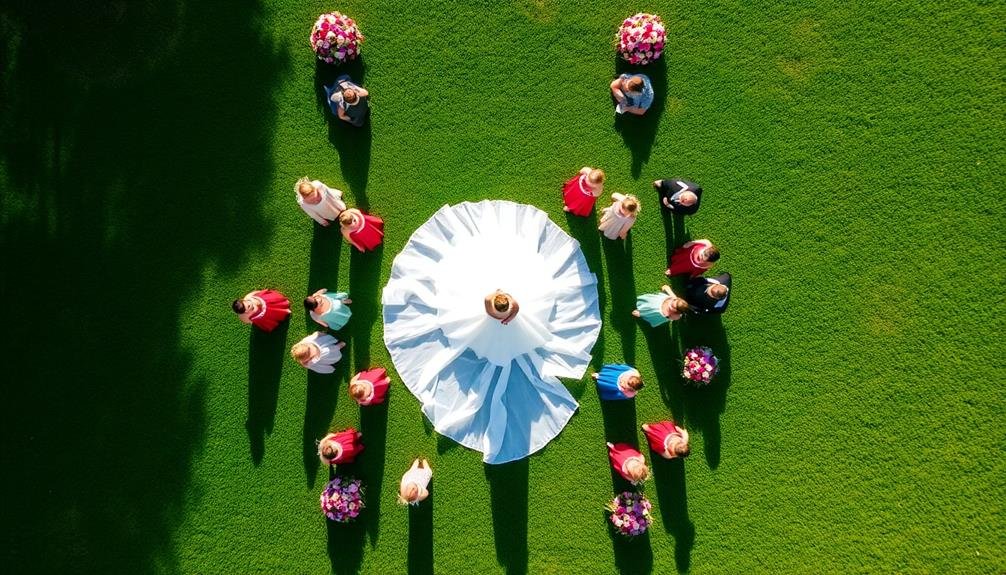



Leave a Reply